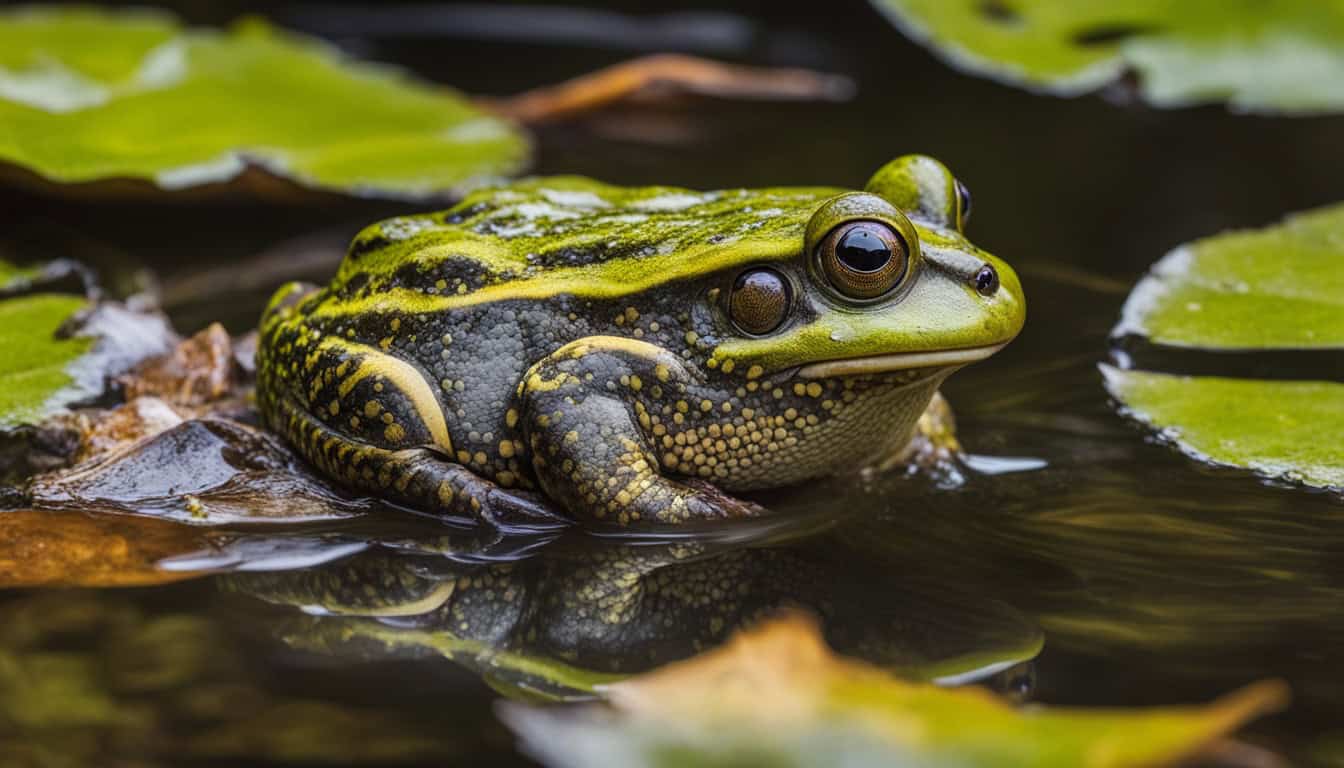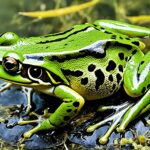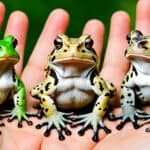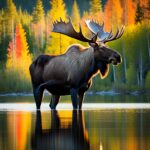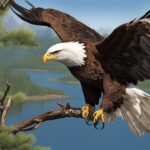Have you ever wondered why the USA has so many amphibians? It’s because of its wide variety of landscapes and climates.
The country’s different habitats help frogs, toads, salamanders, and caecilians thrive. These animals can live from the cold tundras of Alaska to the warm wetlands of Florida. The USA is lucky to have many different kinds of amphibians.
Have you heard the American Bullfrog’s loud croak? Or seen the Colorado River Toad’s burrowing skill? How about the Common Mudpuppy’s cool underwater life? These are just a few examples of the amphibians that call the USA home. They play a big role in our ecosystems, from jumping in jungles to swimming in rivers.
Introduction to American Amphibians
The USA is home to many amphibian species. They live in different spots, like forests and rivers. The United States has about 307 amphibians. This includes 109 frogs and toads and 198 salamanders.
The Diversity of Amphibians
The United States offers various homes for American amphibians. From forests to deserts, there’s a place for many species. This varied land makes room for a lot of different amphibians.
Amphibian Orders in the USA
Three types of amphibians live in the United States:
- Anura: This order includes frogs and toads, both found everywhere in the USA.
- Caudata: This includes salamanders, a big group of American amphibians.
- Gymnophiona: Caecilians, which are strange, legless amphibians, are found in the USA too.
Frogs and Toads: The Anura Order
The Anura order is full of interesting frogs and toads. They can live in many different places in the United States. These amphibians are key to their ecosystems from wetlands to dry deserts.
Characteristics of Frogs and Toads
Frogs and toads in the Anura order have special features. For example, spadefoot toads have spade-like toes for digging. The American Green Tree Frog, from the Bufonidae family, is known for its bright green color found all over the USA.
Distribution of Frogs and Toads in the USA
Common USA amphibians are found all over the country. This shows how well they can adapt and survive. American Green Tree Frogs are most seen in the southeast. Frogs and toads are crucial for the environment, whether it’s in wetlands, forests, or cities.
Salamanders: The Caudata Order
The Caudata order brings us a great variety of salamanders in the USA. These unique creatures can live and thrive in water. Their features and behaviors set them apart from other amphibians in the world.
Traits of Salamanders
Salamanders in the Caudata order have some interesting characteristics. They have long bodies, smooth skin, and can breathe through their skin. Some species can even live their whole lives underwater. This shows how adaptable these amphibians from the USA are.
Popular Salamander Species in the USA
The USA has many famous salamander species. For example, the amphiumas look like eels but are actually amphibians. Then there’s the unique Barton Springs Salamander. It uses its skin to breathe, showing the amazing variations in the Caudata order.
| Species | Habitat | Unique Traits |
|---|---|---|
| Amphiumas | Swamps, ponds, and slow-moving streams | Elongated bodies, reduced limbs, ability to bury in mud |
| Barton Springs Salamander | Barton Springs in Texas | Skin respiration, lungless |
Caecilians: The Gymnophiona Order
The Gymnophiona order, home to caecilians, is not often talked about in the USA. These creatures look like snakes but are actually amphibians. Their lack of limbs and long bodies help them move underground like worms. Caecilians have special features that make them perfect for digging and living below the surface.
Most Gymnophiona, including caecilians, are in Mexico, but a few reach the USA. What makes them interesting is their unique looks for living underground. They have eyes hidden by skin or bone and strong, shovel-like heads. These are ideal for digging.
Caecilians do more than intrigue us. They are important for keeping nature in balance. They eat earthworms and small bugs, which helps keep their numbers in check. Furthermore, as they burrow, they help air to reach the soil, which is good for the environment.
The Gymnophiona order stands out as an unusual and highly-specialized group of amphibians in the USA. Their mystery fascinates both scientists and fans.
Getting to know caecilians better shows they play a unique role in the US amphibian world. They are more than just interesting; they are essential for a healthy environment.
| Characteristic | Description |
|---|---|
| Body Shape | Elongate and limbless, resembling worms or snakes |
| Burrowing Adaptation | Shovel-shaped heads for efficient digging |
| Eye Structure | Often covered with skin or bone |
| Diet | Primarily earthworms and small invertebrates |
| Ecological Role | Soil aeration and invertebrate population control |
The American Bullfrog: A Common Sight
The American Bullfrog stands out among amphibians in the USA. It’s known for its unique calls. This frog is found across the Eastern USA and Canada.
Habitat of the American Bullfrog
The American Bullfrog lives in many places, like ponds, lakes, and marshes. It also can live in places like reservoirs made by people. It can hibernate underwater to survive cold weather. This allows it to live in many different climates.
Physical Characteristics
This frog has an olive-green color and yellow throat, particularly in males. It can grow up to 8 inches long, among the largest in North America. Their strong legs help them jump and swim well.
Feeding and Breeding Habits
The American Bullfrog eats insects, small fish, and other frogs. This makes it a top predator in many water areas. Males make loud calls like a bull during the breeding season. This attracts females to lay eggs in shallow water.
What are the most common amphibians in the USA?
The USA is full of amphibian species that love different places. The American Green Tree Frog, the Common Mudpuppy, and the Colorado River Toad are well-known. They each have special traits that stand out.
American Green Tree Frog
The American Green Tree Frog is a bright, little frog mainly in the southeast. It stands out with its vivid green color and unique call. This frog symbolizes Georgia. They live near water like swamps, marshes, and climb well. You can often see them on plants at night.

Common Mudpuppy
The Common Mudpuppy is an aquatic creature found in the Great Lakes and the northeast. It is active at night and keeps its gills. This lets it live underwater. It likes quiet, slow water where it searches for food at night, such as bugs, worms, and tiny fish.
Colorado River Toad
The Colorado River Toad is the largest toad in the USA’s Bufonidae family. It lives in the southwest, in places like Arizona and California. These toads like the desert. They are big and have strong toxins that keep them safe.
| Species | Habitat | Distinctive Features |
|---|---|---|
| American Green Tree Frog | Southeastern USA (near water sources) | Bright green color, state symbol of Georgia |
| Common Mudpuppy | Great Lakes and northeastern water bodies | Nocturnal, retains gills for life |
| Colorado River Toad | Southwestern USA (desert climates) | Largest native toad in the USA, defensive toxins |
Aquatic Wonders: The Amphiumas
Amphiumas are fascinating amphibians found in the USA. They have a long, eel-like shape and very small legs. These creatures, unique to the United States, have special features that help them live in water.
Types of Amphiumas
There are three kinds of amphiumas based on their toes: one, two, and three. Let’s look at each type to understand them better:
| Species | Description |
|---|---|
| One-Toed Amphiuma | This rare species features only a single toe on each limb, making it unique within the amphibians in the USA. |
| Two-Toed Amphiuma | Most commonly found in the southeastern USA, this species has two toes per limb and is notably resilient in various habitats. |
| Three-Toed Amphiuma | Distinguished by having three toes, this species is often found in wetlands and swamps, making it an interesting member of the aquatic salamanders category. |
Habitats and Behaviors
Amphiumas live mainly in the southeast, in places like marshes and swamps. They are very good at swimming because of their long shape. They even bury themselves in mud when there’s not enough water.
Even though amphiumas have small legs, they can still hunt well. They eat bugs, small fish, and other frogs. They are active at night and like to hide, which makes them interesting for scientists to study.
The Unique Axolotl: A Mexican Transplant
The Axolotl stands out among North American amphibians due to its unique features. It is especially famous for keeping its young characteristics throughout life. This trait, known as neoteny, makes it a standout in the animal world.
Physical Features
The Axolotl’s look is its most notable feature. Unlike other adult amphibians, they keep their gills. These external gills make them easily recognizable. They also have the amazing ability to regrow lost body parts. This includes limbs, parts of their brain, and pieces of their heart. Because of these features, it’s a unique participant among Endangered amphibians.
Conservation Status
The Axolotl is facing a critical situation, marked as critically endangered by the IUCN. This status underscores the broader issues many North American amphibians are dealing with. Their home in Mexico’s Xochimilco lake complex has suffered heavily from urban growth, water pollution, and invasive species. It’s essential to work on conservation to save the Axolotl. Conservation efforts aim to support their natural habitat and protect them.
Barton Springs Salamander: A Texas Treasure
The Barton Springs Salamander is found only in the Barton Springs pool in Austin, Texas. It’s special because it breathes through its skin. This makes it part of the lungless salamander group.
Habitat and Range
This salamander lives in the clear, fresh water of Barton Springs pool. It’s a key part of the Texas ecosystem. Ensuring the pool stays clean is vital for the salamander’s survival.
Conservation Efforts
Protecting the Barton Springs Salamander is important. It lives in a small area and is at risk. Many groups work hard to keep its home safe and clean. They also teach people why the salamander matters.
This work gives hope that the salamander will thrive for years to come.
| Conservation Efforts | Details |
|---|---|
| Habitat Restoration | Improving and maintaining the environmental quality of the Barton Springs pool to ensure optimal living conditions for the salamanders. |
| Water Quality Management | Ensuring the water remains clean and well-oxygenated to support the salamander’s cutaneous respiration. |
| Public Awareness Campaigns | Educating the public about the importance of the Barton Springs Salamander and its habitat to foster community support for conservation initiatives. |
Hellbender: The Largest North American Salamander
The Hellbender is the biggest salamander in North America. It can grow up to 29 inches long. Its body has lots of wrinkles. These help it breathe through its skin.
Physical Characteristics
The Hellbender has a flat body and a wide, flat head. It’s perfect for living in water. Its wrinkled skin lets it take in oxygen from the water.
This lets it live in fast-moving streams. It’s where there’s more oxygen dissolved in the water. The Hellbender uses its flat toes to hold onto rocks and move around.
Endangered Status
The Hellbender is in danger. It’s almost endangered. Problems like losing its home, pollution, and sickness hurt it. Keeping the Hellbender safe is super important. It shows us if the water is healthy. By learning about the Hellbender, we help save it. This helps keep our rivers healthy too.
FAQ
What are the most common amphibians in the USA?
Frogs and toads are everywhere in the USA. You can see things like the American Green Tree Frog and the Colorado River Toad. They live in many places around the country.
What are the different types of amphibians found in the United States?
The U.S. has many kinds of amphibians – 307 types to be exact. This includes frogs, salamanders, and a rarely seen type without legs called caecilians. So, you have a wide range to find here.
What characteristics define the Anura order in the USA?
Frogs and toads in the USA are pretty cool. They can live in a lot of different homes. Some, like spadefoot toads, are good at digging. The American Green Tree Frog is one you might know.
What makes the Caudata order unique among American amphibians?
Salamanders are a big deal in the U.S. They do things like breathe through their skin and live in the water. You might find the largest one, the Hellbender, interesting.
Are there any caecilian species in the USA?
Caecilians are found more in Mexico than the U.S. They are not well known since they live mostly underground. These creatures are unique because they don’t have legs.
Where can American Bullfrogs be found, and what are their characteristics?
American Bullfrogs live in the eastern part of the USA and up into Canada. These frogs are big and green, with males having a yellow throat. They are pretty hardy and can even live underwater during winter.
What are some notable features of the American Green Tree Frog?
These small, bright green frogs live mainly in the southeast of the country. They are even a symbol for Georgia. They show how well animals can adapt to different homes.
What is unique about the habitat and behavior of Amphiumas?
Amphiumas look a lot like eels and have very tiny legs. They live in wet places and can survive drying up by hiding in mud. There are three kinds, each with a different number of toes.
Why is the Axolotl a significant species among North American amphibians?
The Axolotl is a special salamander from Mexico. It is famous for looking like a baby, even as an adult. It’s very good at healing and needs our help to survive.
What efforts are being made to conserve the Barton Springs Salamander?
The Barton Springs Salamander lives only in Texas’ Barton Springs pool. People are working hard to keep its home clean and safe. This helps the salamander, which breaths through its skin, to stay healthy.
What are the distinguishing traits and conservation status of the Hellbender?
The Hellbender is really big for a salamander, up to 29 inches long. It looks kind of wrinkly and can breathe through its skin. It is important to take good care of these animals as they are close to being endangered.

